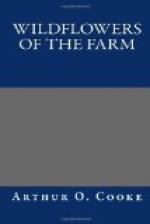[Illustration: GRASSES. 1. Cocksfoot; 2. Sweet vernal; 3. Meadow foxtail; 4. Common Timothy; 5. Tufted hair; 6. Common rye grass.]
The spikelets of Timothy are very small and grow in dense clusters at the end of the stem, so that the blossom forms a kind of tail. Indeed Timothy is sometimes called Meadow Catstail, a name which gives a very good idea of its appearance. This cluster or tail of spikelets is green and also rather rough to the touch. Notice these two points about it; we shall see the reason presently. The green leaves have a greyish tint and are broader than many grass leaves. When cut and made into hay, the leaves are rather stiff and hard.
Timothy grows in good thick clumps, but does not make a very spreading sward. Moist weather suits it best, though it can stand a dry summer fairly well. It is a late grass. Other grasses in the field are in full flower to-day, but there are only a few ears of Timothy to be seen; its flowering-time is July. In one way it is a valuable grass for hay; it is heavy, and hay is always sold by weight. On the other hand Timothy hay is rather hard.
Now here is a grass something like Timothy, yet different in several ways. It is Meadow Foxtail. The ear formed by the cluster of spikelets is of the same shape as an ear of Timothy, like a round tail slightly pointed. But the ear of Timothy was green, while this is a beautiful silvery grey. Timothy was rough; the ear of Meadow Foxtail is very soft and silky to the touch. The silkiness and the silvery grey colour are given to the ear by a soft hair called the “awn” which grows from each spikelet. The leaves are broad and juicy, and there are many of them.
Meadow Foxtail, unlike Timothy, is an early grass; you may find it in flower in April. An early grass is always valuable to the farmer, who wants herbage for his sheep and cattle after the long winter. The Foxtail, moreover, is a spreading grass. Some of its stems are prostrate; they do not stand upright but creep along the ground. From these prostrate stems fresh roots grow and produce fresh plants. Thus Meadow Foxtail makes a good sward.
Another useful grass is Cocksfoot. Each culm has four or five thick clusters of spikelets growing on small stalks of their own. The clusters grow from the culm in a way which reminds us of the claw of a fowl; that is the reason of the name. Cocksfoot is a tall and quick growing plant, and both the stem and flower feel rough and hard. The blue-green leaves are very juicy. The root goes deep into the soil, so that this grass resists drought well.
We must notice the Sweet Vernal Grass, though there is not much of it in the field; for this grass, when it is dry, gives out much of the sweet scent we smell in or near a hay-field. If we chew a stalk, we notice the scent ourselves, and animals like the pleasant flavour which it gives to hay. Though it is an early grass it also lasts till late in the autumn. The spikelets make a cluster or tail at the end of the stalk, but they do not grow so closely together as those of the Timothy and Meadow Foxtail.




